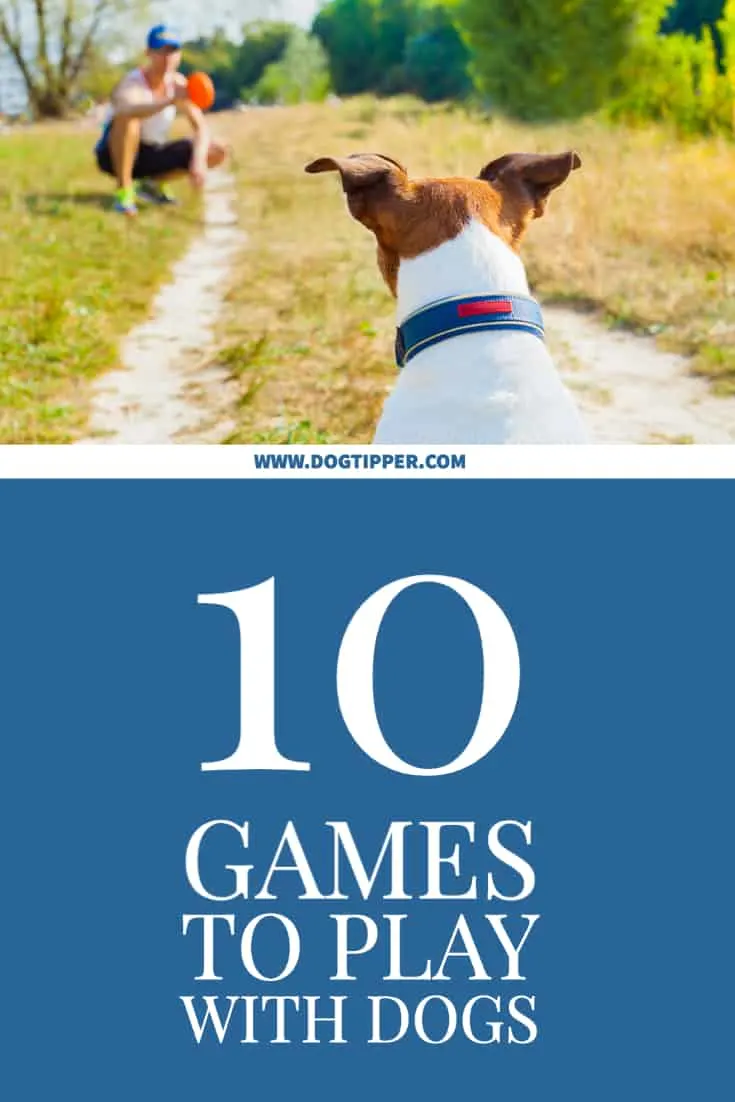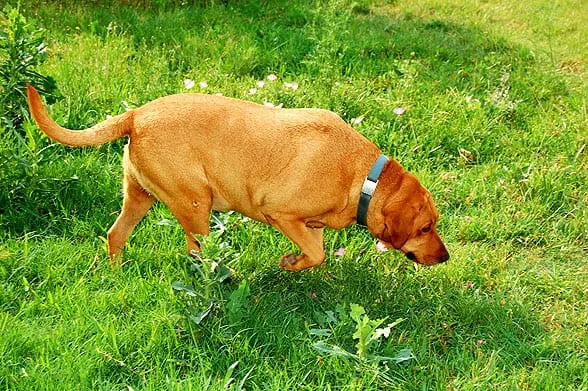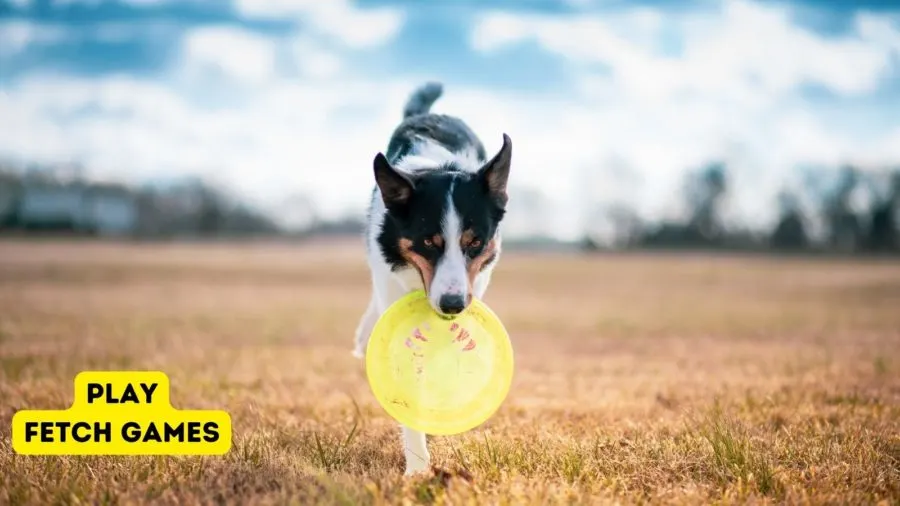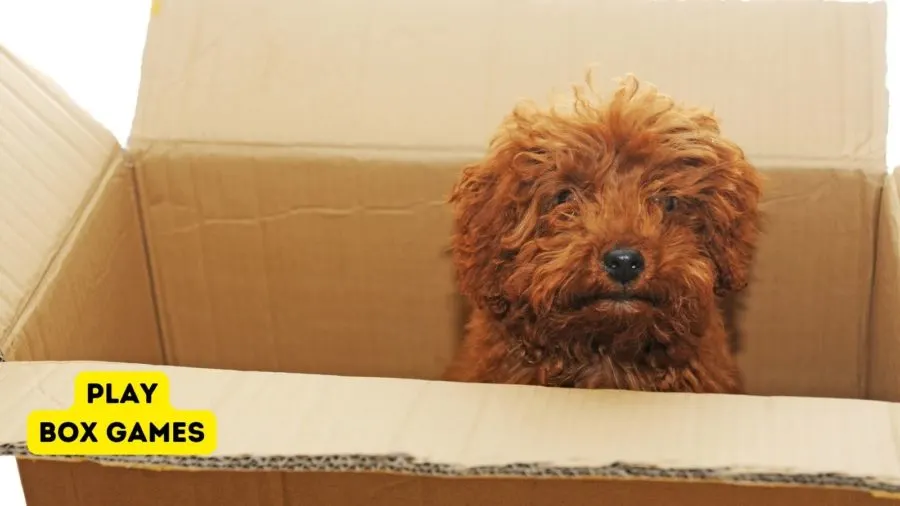Games are a great way to bond with your dog, sneak in a little training and share some fun and exercise at the same time! Whether you are looking for a game to play outdoors or an indoor dog game to enjoy on a rainy afternoon, we’ve got 10 great games to play with dogs!

Hide and Seek
One of our favorites is also super simple. Our version of “hide and seek” was launched as an Easter egg hunt for the dogs, when we hid treats and a couple of boiled eggs in the fresh green grass of our yard for them to find.
Over the years, our hide and seek game has evolved; today we either hide their breakfast meal, divided up around the yard or we hide a few training treats as well as toys and chews in the grass.
Our dogs remain indoors while we hide the prizes but they peek out through the front door to watch.

When we let them out on the porch, we put them in a sit while the excitement grows then release them for this game that not only serves as an active way to serve them their breakfast but appeals to their hunting instincts as well, building upon their powerful scenting skills in the process.
Hide and Seek with a Scent Track
Another way of building on that scent training through outdoor games is laying a scent track. Amy Robinson of Amy Robinson Dog Training instructs owners to “Lay a track by tying a string around the dog’s favorite toy, preferably the one he has just been chomping on since it will have a stronger scent.
“Drag the toy in an L-shaped track, then hide the toy at the end of the track under a big leaf or behind a tree.
“Then bring the dog to the front of the track and help him ‘Find it!’ Watch his overjoyed reaction when he sniffs out the prize and dances around with it. “
Obedient Fetch

Anthony Newman of Calm Energy Dog Training in New York says, “I love teaching outdoor off-leash games with dogs, especially ones that help them learn obedience and manners while enjoying and getting physical exercise and social release.”
One of Newman’s favorite games is “Obedient” Fetch.
Here’s what traditional fetch looks like:
The trainer explains that Obedient Fetch is far different to traditional fetch. “This is in contrast to the kind of fetch you often see in the park:
- Dog barks at human until human bends to pick up ball/stick/toy
- dog steals it and runs away
- this continues several times until human rips ball out of dog’s mouth
- dog barks more, runs in circles around human
- human throws ball/stick/toy
- dog runs and retrieves it, runs off into the woods.
- Eventually this repeats. “
Here’s what Obedient Fetch looks like:
Unlike a traditional fetch game, Newman explains that his game works on four behaviors:
- “Come!” (Recall). Your dog comes all the way over to you with the ball/stick/toy in his mouth. You grab his collar and praise.
- “Drop it.” I prefer to use a combination of audio/visual/physical corrections to make this happen, then reward with happy praise and a treat.
- “Lie down.” Your dog lies down with belly exposed, calm submissive and relaxed.
- “Release” command (e.g. “OK!”) You verbally release your dog and throw the ball/stick/toy. They tear after it, happy as can be.
I’ve done this game with our dogs and they love it; it reminds me of Puppy Pushups (Sit-Down-Up-Down-Up) which we often enjoy indoors on rainy days.
The New York trainer explains, “You’re turning a great, joyful game into a therapeutic behavioral. Whereas unthinking fetch trains dominance, demand barking, demand behavior, and rewards hyperactivity and frustration, ‘Obedient’ fetch trains calm peaceful obedience while exercising and rewarding!”
Newman has one more tip on this training game: “Don’t be strict with all steps of the entire ritual described above when you’re just starting, nor with every throw. The harder any step is for the dog, the sooner and more dramatically and longer you need to reward — e.g. throw the ball several times after he finally drops it. The better he becomes at any step, the more steps you can add, and the sooner you can practice more of them with fewer throws per step.”
Keep Away
If you’re concerned about off-leash game playing, you can also invest in a long leash, often used by Robinson, a long-time dog trainer with an award-winning DVD for kids and dogs entitled Drool School.
“I teach dogs how to work and play in the yard, parks, or any open space where dogs are allowed. Using a long training line, really just a long, lightweight leash about twenty feet in length, allows the owner to play with a purpose, by using commands and interactive body language to forge a great connection and exercise the dog’s brain and body at the same time.”
“One of my favorite games involves playing keep away with the dog. Hold a toy or treat, then try to get away from the dog by continually turning and walking away from the dog. I praise him madly for following me, and if he stays with me for three or four turns, I spike the toy and then chase the dog as he romps away.
“The long line keeps him safe but doesn’t inhibit his fun. The dog thinks he is just playing, but he is learning how to stay close. Then I get the toy back and we start again.”
Follow the Leader
Newman also sneaks in some great safety training as a game as well with his Follow the Leader game.
“Most people think the most important thing they need to teach their dog before feeling safe in off-leash spaces, and especially unfenced parks, is Recall. No doubt recall is essential and hugely helpful in many situations. However, even more fundamental to off-leash obedience and safety is what I call ‘Following.’”
Newman explains that this game of following is not Heeling. “The dog can lag 20 yards behind, or even be in front of you if done properly. Instead it means that when you turn your dog turns; where you go, your dog follows or at least soon comes running.”
This game is easy to do and requires no equipment. “The best way to teach Following is by making it a game where you’re actually trying (or at least pretending to try) to get away from your dog!
“First, never walk toward your dog; if he’s in front, head at an angle.
“Then turn sharply; when he gets in front of you, turn sharply again. Zig-zag and you’ll notice him following you even when he’s out in front,” says Newman.
“I enjoy taking this to extremes when multiple paths are available: pretend to walk up one path, and as soon as your dog runs ahead in it, turn around and yell/whoop/whistle and run back and up the other path!
“If done with proper energy/enthusiasm and timing, your dog should come running with a big smile on his face! You’re turning the leadership into a game — obedience training has never been so fun, and so helpful!”
Playing Chase
Diane Silver, founder of To Dog with Love, a blog that focuses on staying healthy and active with your dog, trains and competes in agility with her Havanese, Rocco. She’s always working on new ways to exercise with him and, for her, many of the best ways involve games.
“It goes back to giving them something that provides both mental and physical stimulation,” explains the Atlanta-based trainer. “Exercise, including games, is great for keeping a dog healthy and happy. Games help to build the bond between you and your dog, keep them focused and help to create a happier and healthier dog.
“I run around the house, and Rocco chases me. I weave in and out of chairs; he thinks it’s the most fun ever, and we both get exercise.”
Along with being an activity that they can share indoors, regardless of weather, Silver points out that the game also helps with her agility training.
“We compete in agility and really that’s just a giant game of chase with obstacles in the middle. Playing chase provides a terrific foundation for agility, keeping Rocco focused on me while having loads of fun.”
Diane has a path through her home she uses for the game of chase, including a few chairs to add to the fun.
Indoor Fetch And Retrieve
Do you think fetch is just an outdoor game? Think again.
At Silver’s house, “I play fetch in the house and in the back yard. Inside, I play with toys that are soft or fuzzy that won’t break anything, though we will throw the occasional tennis ball inside! Outside I play with discs or a ball with a handle Rocco can grab; they come in all sizes depending on the size of your dog.”
Find It Games
“Find it” is a game that we often play with Barli and Tiki, using hidden treats. In years past, we especially enjoyed it when Irie was recovering from TPLO surgery and couldn’t exercise.
Silver has additional ideas for how to make this game even more exciting.
Along with hiding treats around the house, she explains this same basic game can become “Hide and seek” either with a toy or with a person.
“I go in the other room and hide behind the sofa then release him with our release word, which is ’OK.’ I’ve also hidden treats in an interactive toy and hidden it behind a cushion then tell him to go find it so there’s the toy and the treat reward side to that game.”
The agility competitor points out that these games are excellent for training down stays.
Box Games

Although our cats love boxes, we’d never considered introducing a box to our dogs as a toy and training tool but, in talking with Silver, we now will.
“Box games are awesome because all you need is a box,” says the agility competitor who challenges her dog with the box in all kinds of ways.
“He can get in it and push the box, get on top of it, put his front paws on it, and rotate around on the box. I use little boxes and big boxes. I teach Rocco to back up inside a box.”
Box games can be played with all sizes of dogs, from toy and small breeds to medium, large, and giant breeds as well.
Old Tricks And New
Silver says she sometimes gets Rocco to perform his repertoire of tricks as a fun game and she often teaches him a new trick she found online or in a book—a process designed to challenge her dog physically and mentally through fun.
Every game has limits, and it’s important to know when to call a timeout.
Silver notes that one behavioral sign to watch for, depending on the dog, is overstimulation from play. “I think every dog is different so it’s a matter of knowing your own dog and paying attention to your own dog’s signals. If they’re getting destructive or if happy play turns into something a little too aggressive, your dog may be getting over stimulated.”
A more common issue — and one that we’ve seen in our dogs— can be boredom with a game.
“Keep play sessions short so they don’t get bored,” she recommends. “Keep it fun and keep them wanting more.”
Although Rocco has everyday toys to play with, Silver also has certain toys that she puts away to make play extra special. “I’d tell people to rotate their toys and leave a handful out for play. Rotating toys keeps them new.”
And, just like rotating toys, alternating between the games themselves will keep dogs interested with training and exercise that just seems like old-fashioned fun.
On that next rainy day when our afternoon walk is postponed, we’re looking forward to trying out these games for both fitness and fun!
- Review: Jimmy BX7 Pro Anti-Mite Vacuum Cleaner - December 16, 2024
- 🎉 GIVEAWAY: Lord of the Pets Portrait of Your Dog! - November 26, 2024
- Review: Lord of the Pets Portraits - November 17, 2024
